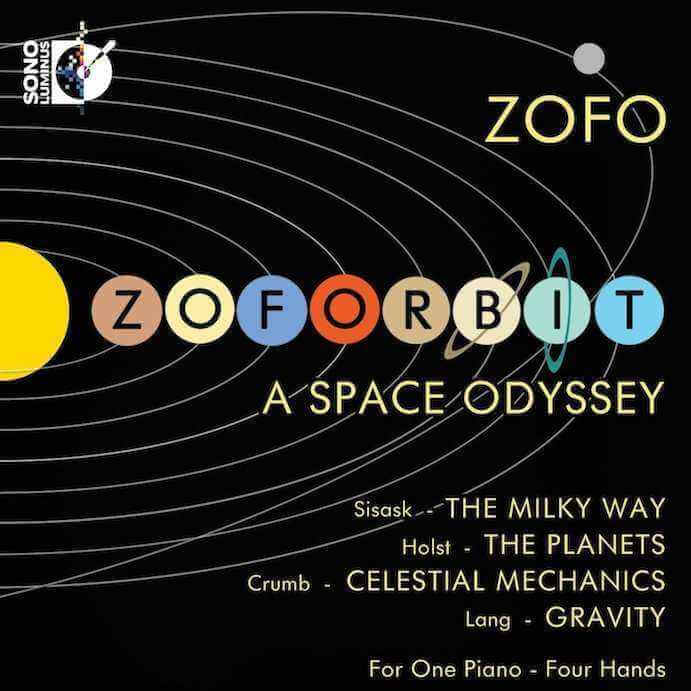Confronted with the title “A Space Odyssey,” memories of HAL 9000’s all-knowing red gaze and my own childlike wonder for that mysterious black monolith pervade my mind (I mean, seriously, what was that monolith thing?). Though, for all its MacGuffin plot devices fueled by “Big Dumb Objects,” Stanley Kubrick’s eponymous film instilled a wonder of creation, the unknown, and of the infinite possibilities of space. For all its inability to travel in the vacuum of space, ZOFO’s music in ZOFORBIT: A Space Odyssey manages to immerse us in an odyssey of its own. Conceived as a combination of ZO (signifying “twenty”) and FO (signifying “finger orchestra”), ZOFO is a piano duo featuring Eva-Maria Zimmermann and Keisuke Nakagoshi performing four-hand arrangements of orchestral pieces. ZOFORBIT is anchored by Gustav Holst’s familiar Planets Suite and features space-themed contemporary works by Urmas Sisask, George Crumb, and David Lang. Performed in the medium for four-hand piano, the album promotes a sense of emptiness and spatial distance in the music—an ideal theater for exploring the unknown.
ZOFORBIT begins with Sisask’s The Milky Way, a piano sonata for four hands. Inspired by astronomy, Sisask’s “astro-music” comes to fruition through a modal scale consisting of the notes C#, D, F#, G#, and A—one similar in form to the Japanese pentatonic scale. Indeed, this unique system creates the ethereal series of rising scales, escalating out of oblivion, weaving and overlapping each other. The piece exhibits its own exoticism, attributed to unique percussive techniques; the performers play both inside and outside the instrument, hammering the ivory, while, at times, strumming and muting the strings themselves. The dichotomy of timbres expand the possibilities of the piano—permitting us to explore unfamiliar realms.

ZOFO
A four hand rendition of Holst’s Planet Suite follows Sisask’s work—a necessary addition that completes any space-themed instrumental album. The Planets maintains an important place in any listener’s heart; indeed, many of us have favorites (mine are “Jupiter” and “Neptune!”). Though many (myself included), are only familiar with the orchestral arrangement. In truth, the suite was originally scored for four-hand piano (except “Neptune,” which was scored for organ). Though ZOFO’s arrangement returns the legendary works to their intended medium, it does not present the splendor and gravitas that I so enjoy in my Planets. I recall, years ago, sitting in the car in my high school parking lot hearing “Jupiter” on the radio and turning it up to where the car would vibrate in seeming celebration; I used to tell myself, if this was the last piece of music I ever hear, I would be content. Though, the crashing brass, booming percussion, and zooming strings are absent in ZOFO’s rendition. Rather, Zimmermann and Nakagoshi give a somewhat minimal rendition, exemplified by brusque notes and empty spaces. Though the performers provide a magnificent interpretation of the individual instrumental voices in their arrangement, the timbral uniformity of the piano rendition demonstrates a lonelier depiction of space.
Crumb’s Celestial Mechanics: Cosmic Dances for Amplified Piano proceeds with a mood of chaos and subtle movement. ZOFORBIT features the first two movements of the suite, “Alpha Centauri” and “Beta Cygni.” “Alpha Centauri” is a tumultuous conglomeration of styles and techniques. Abrupt, percussive tones are clustered in piercing dynamics. These punctuations in empty space provide a more active challenge to that which preceeded (Holst’s mysteriously fading “Neptune”). “Beta Cygni” is notably less frenzied, illustrating restrained, peripheral stirrings in the void. Movement is minimized to discreet musings of various timbres. The piano strings are manipulated to create drumming, popping, and muted effects.
Gravity by David Lang offers a repose from the turbulence of the previous entries, demonstrating a slow, steady descent. Indeed, the music is in perpetual motion, falling downward in steady, relentless tones. While listening, I felt the weight of each subsequent tone, illustrating gravity’s inevitable draw towards the center. Indeed, Gravity’s predictability is arrived at by the same journey followed by composers for centuries—that which leads to the tonic. A dominant pedal point chimes at intervals, foreshadowing its predestined resolution. At the conclusion, the final iteration of descent is accomplished at the tonic—a fitting end to our voyage. From the depths of Sisask’s Milky Way to Holst’s reverent Planets and Crumb’s eclectic musings, our galactic epic concludes.

